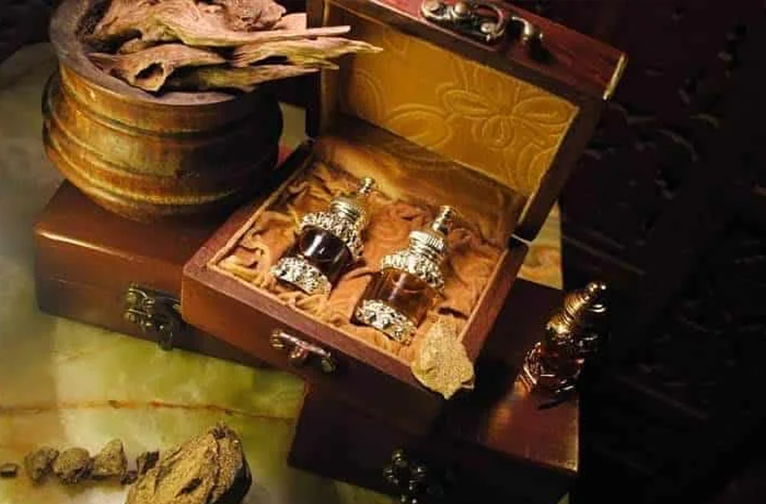A little town in Uttar Pradesh, Kannauj, just two hours away by road from Lucknow, has been the heart of India’s attar-making traditions from as far back as the 6th century when the great King Harshavardhan was ruling northern India. Even today distillers still follow the time-consuming labour-intensive, no-machines method of hydro-distillation or ‘deg bhapka’ to create attars. Attar preparations are organic, non-chemical, and non-alcoholic. As sustainable lifestyle choices, the single-note fragrances of Kannauj, derived from ancestral artisanal skills, will have great appeal for responsible travellers.
The unalloyed pleasure of discovering a scent that boosts your mood with its evocative notes takes you on an exciting journey across India. Organic perfumes, or the Arabic attar/ittar, have for centuries been an intrinsic part of Indian cultural traditions– be it in the spiritual rituals, in our cuisine or for cosmetic use….and that’s not all. The earliest record from where we get our first notes of this precious tradition is the Brihat Samhita, an encyclopaedia put together by the 6th century philosopher Varahamihira from the town of Ujjain in Madhya Pradesh. This highly accomplished veteran is also known for his pursuits in the realms of astronomy, astrology and mathematics.
Attar-making involves aromatic oils being extracted from natural sources such as wood, plants, flower petals, herbs, and spices.
Quintessential ingredients of Indian attar traditions are naturally sourced sandalwood, oudh, saffron, and vetiver (khus). One of these most prized ingredients, oudh, sourced from agar trees, is an oil from one of the rarest and most expensive heartwoods. In India, they grow in Kerala, Assam and Odisha. The roadmap for sourcing core ingredients for India’s attar-making business includes Kannauj, famous for its full-bodied roses, Odisha for kewra, Tamil Nadu for sandalwood, Kashmir for saffron, Uttar Pradesh for khus and Kerala for spices.


By tradition, the base oils used to capture the evanescent distillations in copper stills are sandalwood, jojoba or vetiver. The distilled scents are stored for longevity in camel skin bottles or kuppis. From generation-to-generation families are known to have held fast the secret formula of each attar produced at their distilleries to maintain their exclusivity. ‘Warm ittars’ for winter are musk, amber and saffron (kesar); in summer one should go for ‘cool ittars’ like rose, jasmine, khus, kewra, and mogra.
The zenith of attar-making traditions in India was achieved during Mughal rule and under the Awadhi Nawabs. The emperor Akbar had an exclusive department (khushboo khana) which oversaw fresh developments of perfumes for religious and cosmetic purposes as well as for culinary experiences. The empress Nurjehan had a special affinity to rose ittars.
Scents, whether they are woody, spicy, musky, smoky, citrusy or floral ¬can alter our emotions and moods over all other sensory experience. Unfailing popular are fragrances such as Oudh, Hina, Shamama, Motia, Khus, Chandan and Gulab.
Kannauj
In Kannauj, a must-have scent is the unique ‘mitti attar’–a glorious fragrance that has captured the evocative scent of rain soaking into dry earth. Another hot favourite is Shamama, a distilled blend of 40 or more flowers, herbs, and resins. Check out the offerings of Perfumery Tourism run by an eighth-generation perfumer, Pranav Kapoor.
Delhi
In the heart of Shajhenabad, or Chandni Chowk muscle your way through the crowds in Dariba Kalan and lose yourself in the scented atmospherics of Gulab Singh Johrimal, a perfumery which dates back to the times of the Mughals. They produce and sell their own attars of which they have an excellent variety. Also on sale are incense sticks, essential oils, and soaps. Attar House, near Jama Masjid, is another popular shop. In Connaught Place on Janpath check out Arihant Fragrances - Shop No 17. Explore the offerings of the Perfume Library at Good Earth - Shop No.9 A.B.C. Ground 1st & 2nd Floor, Khan Market and Select City Walk Mall, Saket. When you are done exploring Humayun’s Tomb cross over to the maze of bazaar lanes of Nizamuddin Basti to check out the offerings of the attar-selling shops such as Al-Noor, Qabil and Zam Zam which is reputed for its Topaz, Fawakeh, Hajr-e-Aswad, Saut-ul-Arab, and White Oodh attars.
Lucknow
In the old sheher (Old Quarter) wend your way through the crowded lanes, dodging rickshaws coolies, ruminating cows and sleeping dogs past shop fronts showcasing silver ware, brassware, chikankari work, textiles, toys, mounds of rose petals and marigold which draw your attention to the exotica of the attarwala. The Nawab’s of Oudh have left an indelible mark on the city’s cultural pursuits– especially when it came to using attars. Nawab Wajid Ali Shah, no mean exponent of the classic Indian volatile dance form of Kathak, in which he could work up a bit of sweat, is known to have kept himself fresh and fragrant with the use of the Hina Attar, a blend of over 35 different spices, herbs, flowers, and wood oils in a base of sandalwood made specially for him. In
Hyderabad
Explore the Char Minar area to find your favourite organic scent at the attar shops that abound here in this city of the legendary Nizams. For the real thing try Bhagwan and Company, Hyderabad Perfumers in Pather Gatti, Ajmal Perfumes in Abids, New Gulzar.Co at Moazzam Jahi Market, and Deccan Bahar at Afzal Gunj.
Since perfumes are also used on the skin, even if it’s a single drop it makes total sense to go for attars that are naturally sourced and distilled. So when you are travelling through India next do a bit of homework on the places you will visit to find out the nearest attar shop to go on a perfume adventure of another kind…